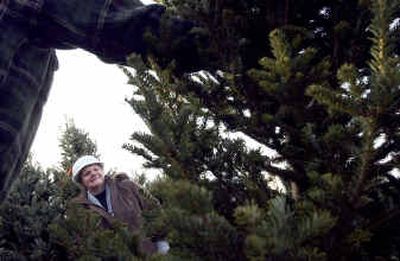Christmas tree hunters go wild

Thousands, if not millions, of Christmas trees are available to local residents at steep discounts from the tree lot prices. Many of the specimens would appeal only to Charlie Brown, but persistent hunters routinely haul symmetrical, full-bodied trees from Inland Northwest national forests.
All it takes is a permit from the U.S. Forest Service, a bit of driving and a couple dozen pulls on a handsaw. Like most bargains, there’s a catch, said Forest Service spokesman Rex Holloway.
“By the time you add gas and everything else, you would probably break even with going to a tree lot,” Holloway said.
Still, devotees say there’s nothing like fleeing the busy holiday shopping scene for an afternoon in the forest.
“For most people, it’s all about the outing. It’s a family experience,” Holloway said. “I’ve seen some pretty pathetic trees come out of the forests, but the people were always happy.”
The best wild Christmas trees are often found growing in previously logged areas or under powerline right of ways, Holloway said. The open canopy allows for the uniform, conical shape prized by many. Others take to the forest looking for trees that could never be found for sale at city lots. Some find beauty in the natural looks of a forest-grown tree, or seek specimens not grown on farms, such as a ponderosa pine or hemlock.
The ponderosa pine, which has long needles and spindly branches, is an unwilling host for lights and ornaments. Hemlock, with its droopy top and rubbery branches, probably qualifies as a “the absolute worst Christmas tree,” Halloway said, which is exactly what some people want.
Wild trees account for only a fraction of the live trees sold in the region. Roughly 2,000 permits are sold each year from the Colville National Forest. The Panhandle national forests will probably sell about 2,000 permits this season, which is down a third from 2002, said Stacie DeWolf, forest products coordinator for the Forest Service’s northern region of North Idaho and Montana.
DeWolf isn’t sure why fewer people are hunting trees. The high cost of gas could be playing a role, she said. Or it might be the growing number of non-profit groups selling trees from lots. Or it just might be people have less time.
“The older generation really had that spirit of going out and getting their own tree,” DeWolf said. “The faster-paced society is looking more at the lots. I know I do. It’s much, much easier to just go to a lot and pick out a tree than it is to take a day in the woods.”
After taking a beating from the sales of artificial trees, live Christmas trees appear to be making a comeback, according to statistics from the National Christmas Tree Association. Last year, 23.4 million live trees were sold in the United States. This season, up to a million more will be sold, according to results of a national survey published on the group’s Web site.
Leland Johnson, who farms Christmas trees in Cocolalla, Idaho, said business is improving.
“The last few years it’s really been a good market,” he said. “For the last several years we’ve sold everything that we have available.”